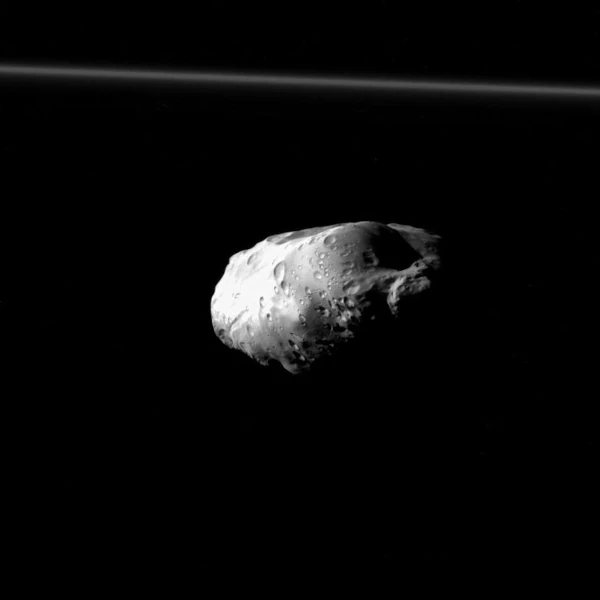
Prometheus orbits at an average distance of 139,380 km from Saturn’s center, with a very low eccentricity of 0.002 and an almost zero inclination of 0.0° relative to Saturn’s equatorial plane. This nearly circular and slightly inclined orbit allows Prometheus to interact closely with the F ring. The moon plays a crucial dynamic role by transferring angular momentum to the ring particles, generating local gravitational resonances that shape its structure and maintain certain arcs of material. Its orbital period of approximately 0.61 sidereal days makes it a fast satellite capable of influencing the ring several times per Saturn rotation.
The surface of Prometheus is heavily cratered, indicating a history of bombardment by micrometeoroids and small bodies. It also features cliffs and escarpments several kilometers high, as well as grooves and fissures that may result from gravitational stresses and tidal forces exerted by Saturn. Some less-cratered areas suggest recent geological activity, probably due to minor collapse of surface material or landslides induced by variations in gravitational forces during close passages relative to the F ring. The texture and color of the surface, measured via infrared spectroscopy, reveal a composition dominated by water ice with dark deposits of organic material or silicates.
Prometheus is a small moon measuring approximately 86 × 62 × 62 km, with a strongly irregular shape suggesting a history of collisions and incomplete accretion. Discovered in 1980 by David C. Jewitt (born 1948) and Edward C. Dunlap (born 1949), this moon follows an orbit very close to Saturn’s F ring and exerts a significant gravitational influence on its structure.
Prometheus’ interactions with the F ring produce waves and disturbances, forming "channels" and arcs of material that evolve in real time, a phenomenon observable thanks to data from the Cassini mission. The orbital proximity of Prometheus and the F ring provides a spectacular example of small-scale gravitational dynamics in the Saturnian system, highlighting exchanges of angular momentum and orbital resonance effects between satellites and rings.
The F ring is a narrow and dynamic ring located approximately 140,180 km from Saturn’s center, with an average width of only 500 km. Its structure is highly irregular, consisting of twisted strands, arcs of material, and narrow channels, a direct result of gravitational interactions with the moons Prometheus and Pandora, which act as "shepherds" of the ring.
The F ring material consists mainly of water-ice particles ranging from micrometers to several meters in diameter, but it also contains dark dust and organic compounds. Gravitational perturbations produce oscillations and particle jets, creating stable arcs over periods of several days to a few weeks. Observations from the Cassini mission have revealed that these arcs are not uniformly distributed and that local density can vary significantly, making it one of the most dynamic and complex ring systems in the Solar System. Studying the F ring provides valuable insights into planetary ring physics, small-scale orbital dynamics, and resonance effects between satellites and particles.
Prometheus’ gravitational influence causes ripples, "braids" (twisted strands), and arcs of particles within the F ring. During close passages, the moon attracts particles, creating "jets" of material that move ahead of and behind its orbit. These interactions cause a constant renewal of particles, redistributing ring material and contributing to its dynamic stability. Numerical simulations and observations from the Cassini mission show that these phenomena are closely linked to variations in Prometheus’ orbital speed and the tidal forces exerted on icy particles.
Prometheus perfectly illustrates the complex dynamics of Saturn’s moons and the F ring. Its small size does not prevent it from playing a crucial role in the stability and redistribution of ring particles.
| Moon | Dimensions (km) | Average distance from Saturn (km) | Role in the F Ring |
|---|---|---|---|
| Prometheus | 86 × 62 × 62 | 139,380 | Creation of ripples and redistribution of particles |
| Pandora | 84 × 62 × 62 | 141,700 | Ring-stabilizing effect, complementary gravitational interaction |
| Atlas | 30 × 20 × 20 | 137,670 | Clearing particles near the A ring, outer ring boundary |
| Epimetheus | 116 × 113 × 108 | 151,400 | Gravitational interaction with Janus, indirect influence on outer rings |
| Janus | 179 × 160 × 154 | 151,500 | Orbital sharing with Epimetheus, role in confining outer particles |